
2006/05/18 23:37:23 34.80N 44.54E 12 4.2 Iraq
USGS Felt map for this earthquake
USGS Felt reports page for Irag
SLU Moment Tensor Solution
2006/05/18 23:37:23 34.80N 44.54E 12 4.2 Iraq
Best Fitting Double Couple
Mo = 1.66e+22 dyne-cm
Mw = 4.08
Z = 12 km
Plane Strike Dip Rake
NP1 315 60 -70
NP2 99 36 -121
Principal Axes:
Axis Value Plunge Azimuth
T 1.66e+22 13 31
N 0.00e+00 17 125
P -1.66e+22 68 266
Moment Tensor: (dyne-cm)
Component Value
Mxx 1.17e+22
Mxy 6.75e+21
Mxz 3.51e+21
Myy 1.84e+21
Myz 7.52e+21
Mzz -1.35e+22
##############
###################
###################### T ###
-------################ ####
-------------#####################
------------------##################
---------------------#################
------------------------################
--------------------------##############
#----------------------------#############
#------------- -------------############
##------------ P --------------###########
###----------- ----------------#########
###------------------------------#######
#####----------------------------#####--
######---------------------------##---
#######-----------------------------
##########-----------------#####--
##############################
############################
######################
##############
Harvard Convention
Moment Tensor:
R T F
-1.35e+22 3.51e+21 -7.52e+21
3.51e+21 1.17e+22 -6.75e+21
-7.52e+21 -6.75e+21 1.84e+21
Details of the solution is found at
http://www.eas.slu.edu/Earthquake_Center/MECH.EU/20060518233723/index.html
|
STK = 315
DIP = 60
RAKE = -70
MW = 4.08
HS = 12
The surface-wave is preferred. Rake is least well determined.
The focal mechanism was determined using broadband seismic waveforms. The location of the event and the and stations used for the waveform inversion are shown in the next figure.

|
|
|
The program wvfgrd96 was used with good traces observed at short distance to determine the focal mechanism, depth and seismic moment. This technique requires a high quality signal and well determined velocity model for the Green functions. To the extent that these are the quality data, this type of mechanism should be preferred over the radiation pattern technique which requires the separate step of defining the pressure and tension quadrants and the correct strike.
The observed and predicted traces are filtered using the following gsac commands:
hp c 0.02 n 3 lp c 0.10 n 3The results of this grid search from 0.5 to 19 km depth are as follow:
DEPTH STK DIP RAKE MW FIT
WVFGRD96 0.5 310 50 -85 3.65 0.2627
WVFGRD96 1.0 125 45 -95 3.69 0.2403
WVFGRD96 2.0 125 40 -90 3.84 0.3114
WVFGRD96 3.0 165 35 -45 3.87 0.2409
WVFGRD96 4.0 130 20 -80 3.90 0.2773
WVFGRD96 5.0 115 20 -100 3.90 0.3215
WVFGRD96 6.0 310 70 -80 3.91 0.3588
WVFGRD96 7.0 140 25 -70 3.94 0.3917
WVFGRD96 8.0 120 25 -95 4.03 0.4321
WVFGRD96 9.0 120 30 -95 4.05 0.4528
WVFGRD96 10.0 125 30 -85 4.06 0.4661
WVFGRD96 11.0 315 60 -70 4.07 0.4745
WVFGRD96 12.0 315 60 -70 4.08 0.4793
WVFGRD96 13.0 325 65 -60 4.09 0.4791
WVFGRD96 14.0 330 65 -55 4.11 0.4756
WVFGRD96 15.0 150 45 -50 4.13 0.4721
WVFGRD96 16.0 150 45 -50 4.14 0.4702
WVFGRD96 17.0 150 45 -50 4.15 0.4639
WVFGRD96 18.0 160 50 -40 4.17 0.4556
WVFGRD96 19.0 160 50 -40 4.18 0.4444
WVFGRD96 20.0 160 55 -40 4.19 0.4299
WVFGRD96 21.0 160 55 -40 4.20 0.4133
WVFGRD96 22.0 160 55 -40 4.20 0.3949
WVFGRD96 23.0 160 55 -35 4.20 0.3762
WVFGRD96 24.0 160 55 -35 4.21 0.3563
WVFGRD96 25.0 160 55 -35 4.21 0.3354
WVFGRD96 26.0 160 55 -35 4.21 0.3139
WVFGRD96 27.0 160 55 -35 4.21 0.2932
WVFGRD96 28.0 185 40 60 4.24 0.2762
WVFGRD96 29.0 185 40 60 4.24 0.2634
The best solution is
WVFGRD96 12.0 315 60 -70 4.08 0.4793
The mechanism correspond to the best fit is

|
|
|
The best fit as a function of depth is given in the following figure:

|
|
|
The comparison of the observed and predicted waveforms is given in the next figure. The red traces are the observed and the blue are the predicted. Each observed-predicted componnet is plotted to the same scale and peak amplitudes are indicated by the numbers to the left of each trace. The number in black at the rightr of each predicted traces it the time shift required for maximum correlation between the observed and predicted traces. This time shift is required because the synthetics are not computed at exactly the same distance as the observed and because the velocity model used in the predictions may not be perfect. A positive time shift indicates that the prediction is too fast and should be delayed to match the observed trace (shift to the right in this figure). A negative value indicates that the prediction is too slow. The bandpass filter used in the processing and for the display was
hp c 0.02 n 3 lp c 0.10 n 3

|
|
|

|
| Focal mechanism sensitivity at the preferred depth. The red color indicates a very good fit to thewavefroms. Each solution is plotted as a vector at a given value of strike and dip with the angle of the vector representing the rake angle, measured, with respect to the upward vertical (N) in the figure. |
The following figure shows the stations used in the grid search for the best focal mechanism to fit the surface-wave spectral amplitudes of the Love and Rayleigh waves.

|
|
|
The surface-wave determined focal mechanism is shown here.
NODAL PLANES
STK= 320.16
DIP= 60.21
RAKE= -70.71
OR
STK= 105.00
DIP= 35.00
RAKE= -119.99
DEPTH = 12.0 km
Mw = 4.18
Best Fit 0.8500 - P-T axis plot gives solutions with FIT greater than FIT90
 |
The P-wave first motion data for focal mechanism studies are as follow:
Sta Az(deg) Dist(km) First motion KSJS 43 107 P KSBB 76 110 P KEKZ 343 138 P KSWW 23 163 P BHD 185 170 P KSSS 55 188 P KEHH 12 213 P KESM 353 244 P KDDA 330 309 P
Surface wave analysis was performed using codes from Computer Programs in Seismology, specifically the multiple filter analysis program do_mft and the surface-wave radiation pattern search program srfgrd96.
The velocity model used for the search is a modified Utah model .
Digital data were collected, instrument response removed and traces converted
to Z, R an T components. Multiple filter analysis was applied to the Z and T traces to obtain the Rayleigh- and Love-wave spectral amplitudes, respectively.
These were input to the search program which examined all depths between 1 and 25 km
and all possible mechanisms.

|
|
|

|
| Pressure-tension axis trends. Since the surface-wave spectra search does not distinguish between P and T axes and since there is a 180 ambiguity in strike, all possible P and T axes are plotted. First motion data and waveforms will be used to select the preferred mechanism. The purpose of this plot is to provide an idea of the possible range of solutions. The P and T-axes for all mechanisms with goodness of fit greater than 0.9 FITMAX (above) are plotted here. |

|
| Focal mechanism sensitivity at the preferred depth. The red color indicates a very good fit to the Love and Rayleigh wave radiation patterns. Each solution is plotted as a vector at a given value of strike and dip with the angle of the vector representing the rake angle, measured, with respect to the upward vertical (N) in the figure. Because of the symmetry of the spectral amplitude rediation patterns, only strikes from 0-180 degrees are sampled. |
Sta Az(deg) Dist(km) KSJS 43 107 KSBB 76 110 KEKZ 343 138 KSWW 23 163 KSSS 55 188 KEHH 12 213 KESM 353 244 KDDA 330 309
Since the analysis of the surface-wave radiation patterns uses only spectral amplitudes and because the surfave-wave radiation patterns have a 180 degree symmetry, each surface-wave solution consists of four possible focal mechanisms corresponding to the interchange of the P- and T-axes and a roation of the mechanism by 180 degrees. To select one mechanism, P-wave first motion can be used. This was not possible in this case because all the P-wave first motions were emergent ( a feature of the P-wave wave takeoff angle, the station location and the mechanism). The other way to select among the mechanisms is to compute forward synthetics and compare the observed and predicted waveforms.
The velocity model used for the waveform fit is a modified Utah model .
The fits to the waveforms with the given mechanism are show below:
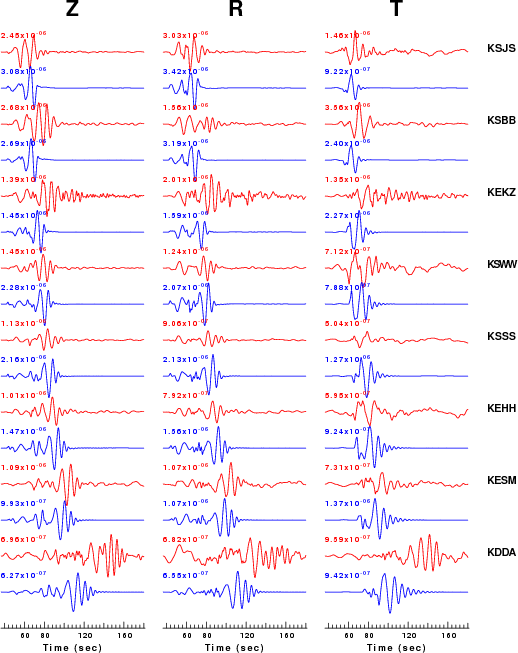
|
This figure shows the fit to the three components of motion (Z - vertical, R-radial and T - transverse). For each station and component, the observed traces is shown in red and the model predicted trace in blue. The traces represent filtered ground velocity in units of meters/sec (the peak value is printed adjacent to each trace; each pair of traces to plotted to the same scale to emphasize the difference in levels). Both synthetic and observed traces have been filtered using the SAC commands:
hp c 0.02 n 3 lp c 0.10 n 3

|

|
Should the national backbone of the USGS Advanced National Seismic System (ANSS) be implemented with an interstation separation of 300 km, it is very likely that an earthquake such as this would have been recorded at distances on the order of 100-200 km. This means that the closest station would have information on source depth and mechanism that was lacking here.
Dr. Harley Benz, USGS, provided the USGS USNSN digital data. The digital data used in this study were provided by Natural Resources Canada through their AUTODRM site http://www.seismo.nrcan.gc.ca/nwfa/autodrm/autodrm_req_e.php, and IRIS using their BUD interface
The figures below show the observed spectral amplitudes (units of cm-sec) at each station and the
theoretical predictions as a function of period for the mechanism given above. The modified Utah model earth model
was used to define the Green's functions. For each station, the Love and Rayleigh wave spectrail amplitudes are plotted with the same scaling so that one can get a sense fo the effects of the effects of the focal mechanism and depth on the excitation of each.
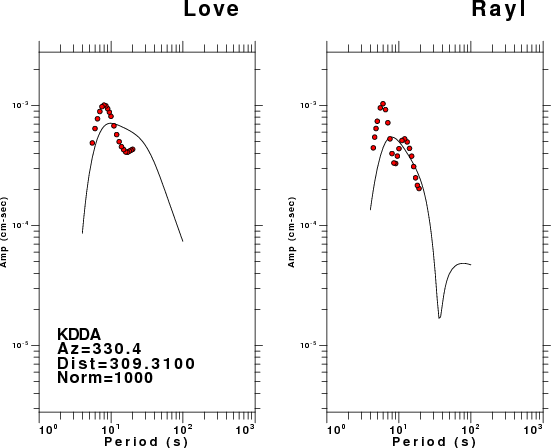 |
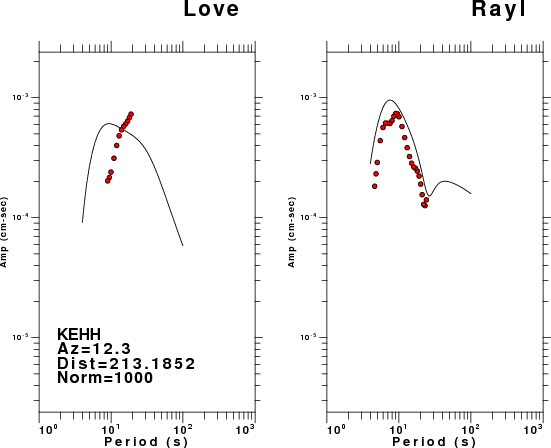 |
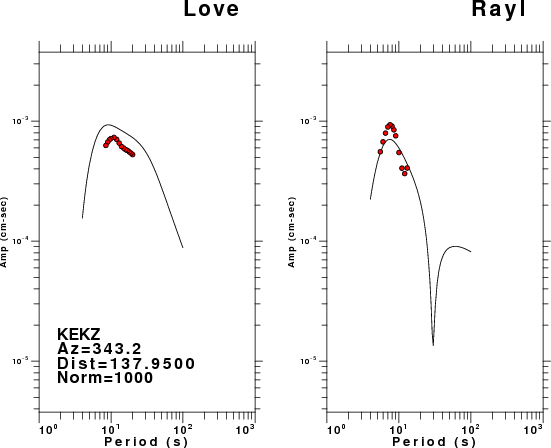 |
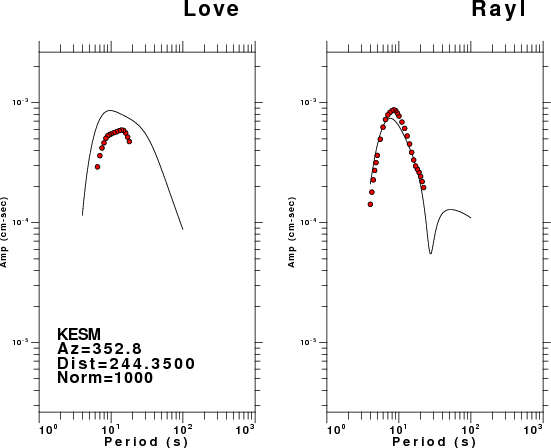 |
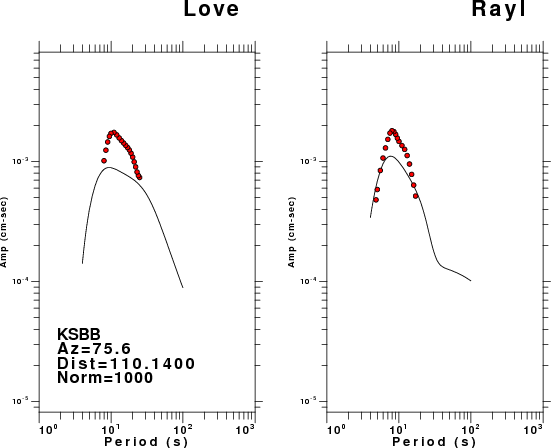 |
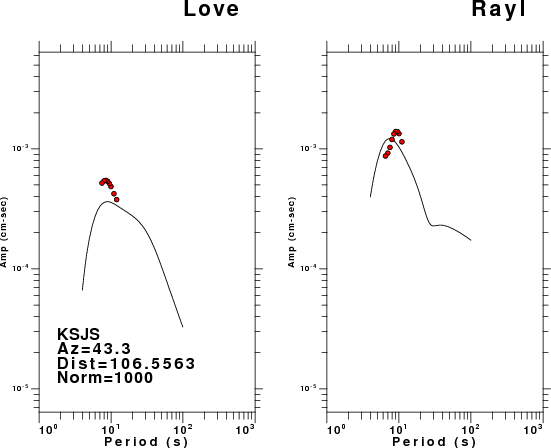 |
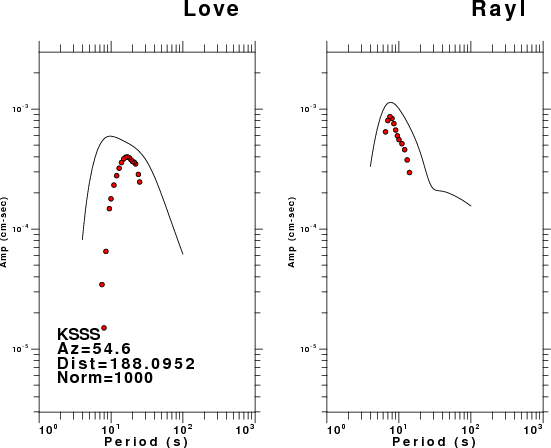 |
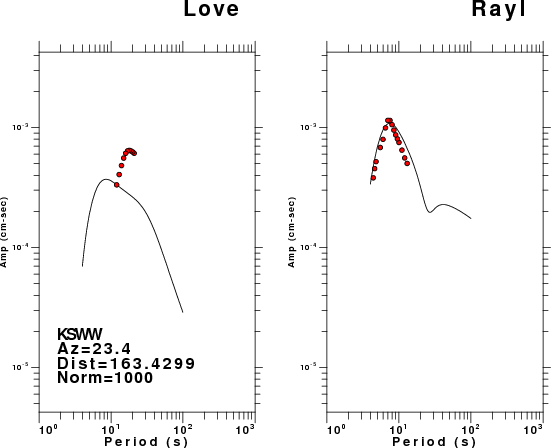 |
Here we tabulate the reasons for not using certain digital data sets
The following stations did not have a valid response files: